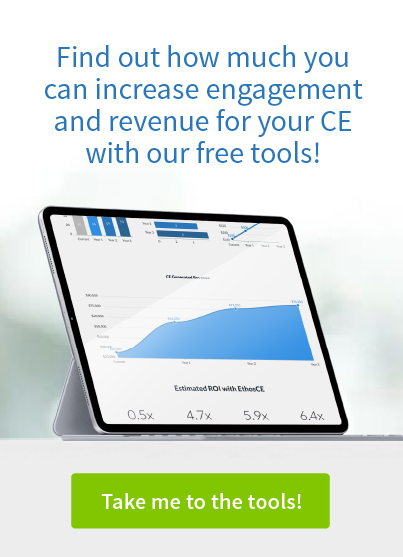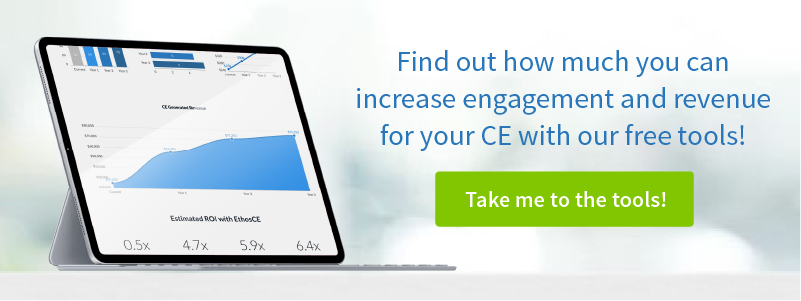Avoiding Risks of Low Cost LMS Systems for Healthcare CE
We get it, you want the best value for your organization’s budget when choosing an LMS. Low-cost LMS options are tempting at first glance, but a closer look will reveal hidden costs, reduced efficiency, and more work than benefits. But how do you determine if a bargain LMS provides real value?
Why Low-Cost LMS Systems are Rarely a Bargain
Low-cost LMS systems present the same dilemma a cheap used car might. Even if it runs well initially, you may quickly find out it can’t go the distance when you need it most.
A cheap LMS is often more of a warehouse of records than an actual learning management system or productivity tool. While it may provide a user interface and navigation system for your students to reach your content, it’ll lack the tools, data, and support needed to provide real educational value.
With a cheap LMS, enhancing learning experiences with immersive educational tools like audio and video would require you to hire a web developer to design them. Also, a cheap LMS rarely provides relief from mounting administrative tasks as a program grows.
Time-consuming data entry tasks that hinder your staff’s productivity as your program experiences its first rush of new students will only become more cumbersome with low-cost LMS systems, as task automation is only available on enterprise-grade platforms.
That means you will either have to quickly hire more staff to cope with the influx of students or burden your existing team until they’ve reached their breaking point. You may also be required to have a web developer at-the-ready to add new curriculum components.
Since web design projects usually take a significant amount of time to plan and execute, it’s possible that your great idea for adding interactive video to help students might not be available for a few months.
While a low-cost LMS might seem like a “bargain” purchase, choosing one can be a costly, time-consuming mistake.
The best way to prevent the risks of a low-cost LMS is to seek authentic value rather than a specific price point.
Enterprise-grade features help your organization save money long-term by preventing the loss of productivity and reduced course completion rates that cut into program profits. Here’s how:
An Enterprise-Grade LMS Protects Workflow Through Task Automation
From emailing and bulk transcript import to course completion certificate printing on-demand, an LMS built to scale will allow you to automate repetitive, time-consuming tasks.
Task automation takes the burden of busywork off of your staff and enables them to focus on customer service and content creation that requires their expertise.
A scalable LMS will provide secure options for amplifying learning experiences with a variety of content tools.
From video to animation to audio content, an enterprise-grade LMS will deliver the capability to add innovative components to activities instantly. That means no waiting for a web developer to create a new plugin or purchasing additional features from the platform provider.
Instead, look for features that:
- Save time by automating repetitive, time-consuming tasks that often interrupt workflow.
- Enable you to easily add new content tools to activities that prove challenging to students.
- Support rapid program growth by providing you with the features that you need to scale on day one.
Takeaway:
- Look for value rather than the lowest price when selecting an LMS.
- Learn to identify the features that save you the most money over time while helping your organization achieve its CME goals.
- Understand why enterprise features are essential to have even before you think you might need them.
Identify Your Essential LMS Toolkit
While you should always be price-conscious when selecting your LMS, certain features are as indispensable to your LMS as brakes are to a car. So what does your organization need in its LMS toolkit?
An advanced, automated, data collection tool
Your LMS should collect data in operation, helping you avoid costly data corruption caused by human error during data entry and keep your staff from getting bogged down with tasks that could be automated.
A comprehensive data analytics suite
Your data is your Swiss Army knife when it comes to dealing with the challenges of growing your educational program in a competitive market. An enterprise-grade LMS, like EthosCE, provides an all-in-one data analytics backend that allows you to compile, slice, and analyze all of your data in a single dashboard.
Compelling content controls designed to give you ultimate flexibility
Adding new types of content to activities should be a breeze when using your LMS, as should creating customized, automated feedback for learners before, during, and after assessments. Advanced features like these improve overall educational outcomes, keep users engaged, and support high course-completion rates.
Takeaway:
- The features that your organization needs to scale should be non-negotiable when selecting your LMS. Don’t sacrifice essential capabilities for short-term savings.
- Task automation, data analytics, and curriculum flexibility are essential components that your LMS should have.
- As your program grows, administrative tasks will mount and the inability to automate repetitive, time-consuming tasks will reduce productivity across your organization.
The Solution? Choose your LMS system based on the most value for your organization and students, not the lowest price.
Scalability and enterprise-grade features determine if your LMS is worth the investment.
A low-cost LMS isn’t a wise budget choice if it requires you to purchase numerous features each time your program grows. From AMS-LMS integrations to administrative task automation, EthosCE allows you to get the most value for your budget by providing all of the features your program will need to grow your learner base, develop a long-term marketing strategy, and create superior educational experiences.
Ready to transform your educational programming without having to be a programmer or hire a web design firm? Take EthosCE for a test drive!
 We're now part of the Cadmium product suite! Learn more
We're now part of the Cadmium product suite! Learn more 


